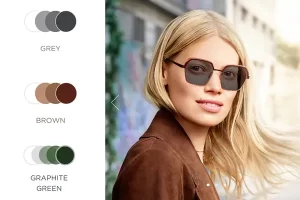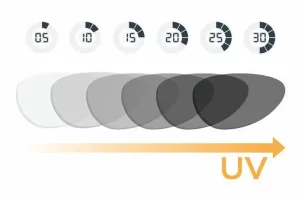Transition glasses lenses, also known as photochromic lenses, are a popular choice for many eyewear users due to their convenience and functionality. In this guide, we’ll explore the basics of transition glasses lenses, their benefits, and how to choose the best pair for your needs.
What Are Transition Lenses?
Transition lenses are a type of eyeglass lens that automatically darken when exposed to UV light and return to their clear state when indoors. This provides the wearer with the convenience of having both prescription eyeglasses and sunglasses in a single pair of frames.
How Do Transition Lenses Work?
Transition lenses contain special photochromic molecules that react to UV light. When these molecules are exposed to UV rays, they undergo a chemical change that causes them to absorb more light, resulting in a darkening of the lenses. When the UV exposure decreases, the molecules return to their original state, and the lenses become clear again.
Benefits of Transition Lenses
There are several advantages to using transition lenses, including:
- Convenience: With transition lenses, you won’t need to carry around a separate pair of sunglasses or constantly switch between your regular glasses and sunglasses.
- UV Protection: Transition lenses provide 100% UVA and UVB protection, shielding your eyes from harmful ultraviolet radiation.
- Comfort: By automatically adjusting to changing light conditions, transition lenses help reduce eye strain and provide optimal vision in various environments.
- Variety: Transition lenses are available in a wide range of lens materials, designs, and prescriptions, making them suitable for various types of eyewear users.
Choosing the Right Transition Lenses for Your Needs

When selecting transition glasses lenses, consider the following factors to ensure you get the perfect pair for your needs:
1. Lens Material
Transition lenses are available in various materials, including:
- Polycarbonate: Lightweight, impact-resistant, and suitable for sports and active lifestyles.
- Trivex: Similar to polycarbonate, but with enhanced optical clarity.
- High-Index: Thinner and lighter than traditional lenses, ideal for those with high prescriptions.
- Glass: Offers excellent optical clarity, but is heavier and less impact-resistant than other materials.
2. Lens Design
Transition lenses come in different designs to accommodate various vision needs:
- Single Vision: Corrects either distance or near vision.
- Bifocal: Provides separate areas for distance and near vision, with a visible line separating the two.
- Progressive: Offers a smooth transition between distance, intermediate, and near vision without a visible line.
3. Color Options

Transition lenses are available in different color options:
- Gray: Provides a neutral view and true color perception.
- Brown: Enhances contrast, ideal for outdoor activities.
- Green: Offers a balance of contrast and true color perception.
4. Lens Coatings
Consider additional lens coatings for enhanced performance:
- Anti-Reflective: Reduces glare and reflections for improved visual clarity.
- Scratch-Resistant: Protects lenses from everyday wear and tear.
- Blue Light Blocking: Filters out harmful blue light emitted by digital devices.
Caring for Your Transition Lenses
To maintain the performance and longevity of your transition lenses, follow these tips:
- Clean your lenses regularly with a microfiber cloth and lens cleaner.
- Store your glasses in a protective case when not in use.
- Avoid exposing your lenses to extreme temperatures, as this may affect their responsiveness.
With the right pair of transition glasses lenses, you can enjoy the convenience of having both prescription eyeglasses and sunglasses in one stylish package. By considering factors such as lens material, design, color options, and lens coatings, you can find the perfect pair to suit your unique vision needs and lifestyle preferences.
Frequently Asked Questions About Transition Lenses
To help you better understand transition lenses, we’ve answered some common questions:
1. How long do transition lenses take to change?

Transition glasses lenses typically take about 30 seconds to darken when exposed to UV light and around 2 minutes to return to their clear state when indoors. Keep in mind that the speed of the transition may vary depending on factors such as temperature and UV intensity.
2. Can transition lenses be used while driving?

Transition glasses lenses may not darken fully while driving, as most car windshields block UV light, which is necessary for the lenses to change. If you require sunglasses while driving, it’s best to use a separate pair of prescription sunglasses.
3. Do transition lenses wear out?
Over time, the photochromic molecules in transition glasses lenses can become less responsive due to prolonged exposure to UV light, resulting in a slower or less complete transition. On average, transition glasses lenses last about 2-3 years before needing replacement.
4. Are transition lenses suitable for everyone?
Transition glasses lenses are suitable for most eyeglass wearers, including those with single vision, bifocal, or progressive prescriptions. However, they may not be ideal for individuals who spend a significant amount of time in environments with varying light conditions, as the lenses may not always provide the optimal level of tint.
Conclusion
In conclusion, transition glasses lenses offer a convenient and versatile solution for those seeking the benefits of both prescription eyeglasses and sunglasses. By understanding the different options available and considering your unique needs, you can select the perfect pair of transition lenses to enhance your visual comfort and protect your eyes from harmful UV rays.

